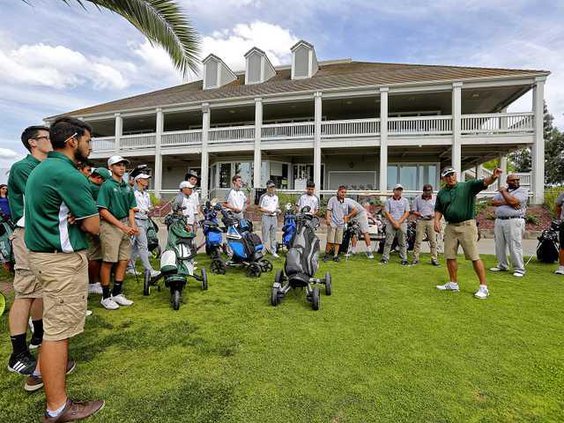Manteca is sticking with a proven operational model for the Manteca Golf Course.
The Manteca City Council opted to continue running the course in the same manner it has for 40 years under the late Alan Thomas who they contracted with as a golf pro with city workers maintaining the course.
That means the hunt is now on to secure a golf pro to take over operations July 1 when the interim contract with Thomas’ widow Marjie Thomas expires.
The council made it clear, though, that golfers should expect to see green fees increased to help offset growing costs. The discussion at Tuesday’s council meeting showed council members want to reduce the gap between operating costs and revenue but they were not in favor of large increases such as 20 to 30 percent in a bid to bridge the gap all at once.
The so-called hybrid model means the city has rejected hiring a management firm, leasing the course, or the city running everything.
The council decision to keep the status quo in terms of the golf course operating model was unanimous. Councilwoman Debby Moorhead was not in attendance.
“As Mr. (Councilman Richard) Silverman indicated, when we get deep into the weeds we will start to find issues as to how we improve the bottom line,” Manteca Mayor Steve DeBrum said.
The course faces two major challenges.
uAn erosion of golf play that reflects national trends going from 74,000 rounds in 2000, to 62,500 rounds in 2010, and to 51,800 rounds in 2016.
uSome $3.47 million worth of capital improvement projects have been identified by staff as being needed and/or are a “wish list” of sorts over the next 10 years. The biggest chunk is $1.8 million needed for the clubhouse that is nearing 30 years in age.
At the same time Silverman noted the city has a lot of other demands for limited funds that a golf course “revenue shortfall” will take from especially if the gap widens. Silverman mentioned other needs such as hiring more police officers, firefighters, and street maintenance workers as well as park maintenance workers plus addressing other amenities such as the library.
The consultant’s study noted over $300,000 a year is spent on the golf course from the general fund in addition to the city’s 90 percent share of green fee receipts and rent.
That includes $155,000 in an annual so-called “subsidy” for junior and golf play that has remained unchanged for more than 14 years. The money essentially backfills on the books the revenue loss the city incurs due to reduced green fees on monthly passes purchased by senior and junior golfers as well as high school golf team play.
There are roughly 1,800 passes responsible for 21,000 rounds of golf play each year.
City Finance Director Suzanne Mallory — answering an inquiry from DeBrum — noted the $155,000 has consistently covered the price differenceo over the years.
The $300,000 plus funding gap that Del Webb resident Bill Barnhart noted should be characterized as an operating cost as opposed to an operating loss since no other recreational facility the city operates outside of the Big League Dreams sports complex pays for itself also includes $215,000 the city contends are costs they incur for management related costs including accounting.
Critics have long contested the cost slapped onto the course — the so-called cost recovery fee — is not justified for various reasons including the fact the staff already exists as well as contending it being too high.
Back in the late 1990s the cost recovery cost approached 25 percent under then City Manager Robert Adams. It was lowered to 20 percent after opponents added administration charge offs to other enterprise accounts for sewer, solid waste, and water to the golf charges and found it reimbursed almost all of the city manager’s office operating budget. The cost recovery charge has been suspended for almost a decade.
DeBrum suggested a surcharge specifically for needed capital improvements could be added on top of green fees assuring the money would be spent for the purpose that it is collected.
The consultant the city hired indicated the city received an average of $12.99 for each of the 51,800 rounds played in 2016 with pass play generating $7.70 a round and regular green fees $16.63 a round.
He said the average fee generated per round by other courses in the region is $18.
To contact Dennis Wyatt, email dwyatt@mantecabulletin.com
Manteca sticks with golf model
Council opts to look for new golf pro





